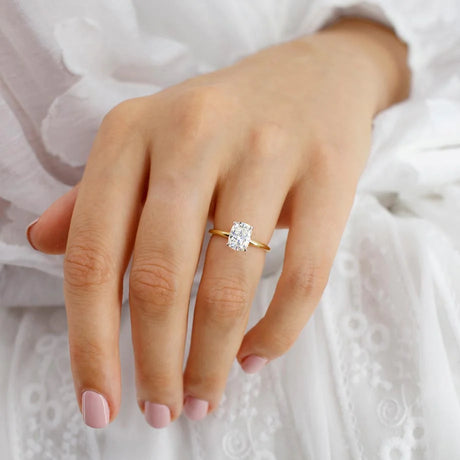Bridal jewellery has long been an essential part of wedding traditions across the world, symbolizing love, commitment, and cultural heritage. Over the centuries, the styles, materials, and significance of bridal jewellery trends have evolved, influenced by cultural shifts, fashion trends, and advancements in jewellery-making techniques. From ancient times to the modern era, the evolution of bridal jewellery reflects changing societal norms while still maintaining its symbolic value.
Ancient Bridal Jewellery
In ancient civilizations, bridal jewellery trends were deeply rooted in tradition and social status. In Egypt, gold jewellery adorned with precious gemstones was worn by brides as a sign of wealth and protection. The Greeks and Romans favored intricately designed pieces, often featuring laurel wreaths, pearls, and engraved motifs symbolizing fertility and eternity. During these times, jewellery was not only an aesthetic adornment but also carried spiritual and superstitious significance, believed to bring good fortune and ward off evil spirits.
Medieval and Renaissance Influences
The medieval period saw the introduction of religious symbolism in bridal jewellery. Crosses, sacred inscriptions, and intricate metalwork became common, reflecting deep faith and devotion. Brides in European aristocracy often wore elaborate necklaces and brooches, signifying their noble status. During the Renaissance, the use of colored gemstones became prominent, with sapphires, emeralds, and rubies symbolizing loyalty, hope, and passion, respectively. Pearls, considered the ultimate symbol of purity, were particularly favored by brides of noble lineage.
The Victorian Era and Sentimental Jewellery
The Victorian era (1837-1901) witnessed an explosion of romanticism in jewellery design. Queen Victoria herself set trends with her love for sentimental jewellery, influencing brides to wear lockets, cameos, and intricate floral motifs. Diamonds gained popularity during this period, especially after the discovery of diamond mines in South Africa. The engagement ring, a tradition that originated centuries earlier, became more widespread, with diamond solitaires emerging as the preferred choice for brides.
Art Deco and the Rise of Glamour
The 1920s and 1930s saw the rise of Art Deco jewellery, characterized by geometric shapes, bold lines, and lavish use of diamonds and platinum. Bridal jewellery became more striking, reflecting the changing roles of women in society. The period also marked the beginning of engagement rings with larger diamonds and intricate settings, emphasizing modern elegance and sophistication. This era firmly established the diamond ring as the ultimate engagement token, thanks in part to De Beers’ famous marketing campaign, “A Diamond is Forever.”
Mid-Century Minimalism and Hollywood Influence
The mid-20th century brought a shift towards minimalism, with brides opting for simpler, more elegant jewellery pieces. Hollywood played a significant role in shaping bridal jewellery trends, with iconic actresses such as Audrey Hepburn and Grace Kelly influencing style choices. Platinum and white gold became popular metals, and diamonds continued to dominate engagement and wedding ring designs. The 1950s and 1960s also saw the emergence of matching wedding sets, where engagement rings and wedding bands were designed as cohesive pieces.
The Late 20th Century: Personalization and Diversity
By the 1980s and 1990s, bridal jewellery trends diversified, with brides opting for more personalized designs. While classic diamonds remained popular, alternative gemstones such as sapphires, emeralds, and rubies gained traction, thanks in part to high-profile royal engagements, such as Princess Diana’s iconic sapphire engagement ring. Yellow gold made a comeback, and intricate vintage-inspired designs became sought after. This era also saw an increased demand for custom-made jewellery, allowing brides to incorporate meaningful elements into their bridal pieces.
Modern Bridal Jewellery: A Blend of Tradition and Innovation
Today, bridal jewellery trends reflect a perfect blend of tradition and contemporary fashion. Brides have more choices than ever, with designs ranging from timeless classics to unconventional and avant-garde pieces. Sustainability has become a key consideration, with many couples opting for ethically sourced diamonds, lab-grown gemstones, and recycled metals. Minimalist jewellery has gained popularity, with dainty necklaces, sleek bangles, and delicate stud earrings complementing modern bridal aesthetics.
Customization remains a significant trend, with brides choosing unique settings, mixed metals, and engraved messages to add a personal touch. Additionally, heirloom jewellery has regained importance, as many brides incorporate family pieces into their wedding ensembles, embracing sentimental value alongside style.
Cultural influences also play a vital role in contemporary bridal jewellery. Traditional designs such as Indian Polki and Kundan jewellery, Middle Eastern gold sets, and Chinese jade accessories continue to thrive, blending heritage with modern craftsmanship. Globalization has made these styles more accessible, allowing brides to experiment with diverse aesthetics that resonate with their personal heritage and fashion sensibilities.
Conclusion
Bridal jewellery has undergone a remarkable transformation over the centuries, reflecting the ever-evolving tastes and traditions of society. From ancient gold ornaments to modern minimalist designs, the essence of bridal jewellery remains rooted in love, symbolism, and personal expression. As the world continues to embrace sustainability and inclusivity, the future of bridal jewellery is likely to be even more diverse, with innovative designs that honor both heritage and individuality.


